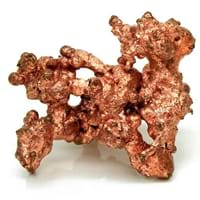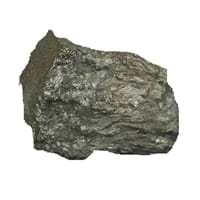Copper Erbium Comparison
Periodic Table
Symbol
Cu
Er
Group Number
11
7
Not Available
Period Number
4
6
Block
d block
f block
Element Family
Transition Metal
Lanthanide
CAS Number
7440508
37
7440520
35
Space Group Name
Fm_ 3m
P63/mmc
Space Group Number
225.00
2
194.00
5
Facts
Interesting Facts
- Copper rarely found in its pure form in nature.
- Copper Sulfate is mostly used in agricultural poison and as an algicide in water purification system.
- Erbium metal is used as alloyed with Vanadium to make it softer.
- Recent studies shows that it is helpful for metabolism.
Sources
Found in Minerals
Mining
History
Who Discovered
Unknown
Carl Gustaf Mosander
Discovery
In Middle East (9000 BCE)
In 1842
Abundance
Abundance In Universe
6 * 10-6 %
12
2 * 10-7 %
22
Abundance In Sun
~0.00007 %
12
~0.0000001 %
26
Abundance In Meteorites
0.01 %
13
0.00 %
36
Abundance In Earth's Crust
0.01 %
17
0.00 %
32
Abundance In Oceans
0.00 %
8
0.00 %
36
Abundance In Humans
0.00 %
9
Not Available
Uses
Uses & Benefits
- It is use for coinage and bullion.
- Most of copper element is used in manufacturing electrical and electronic equipments such as wirings and components. It is also used in construction and industrial machine.
- It has a tendency to get tarnished in the open air, but when alloyed with elements like erbium, vanadium, its hardness levels decreases.
- Its compounds like Erbium oxide is used in safety glasses of welders and metal workers.
Industrial Uses
Chemical Industry, Electronic Industry
Chemical Industry
Medical Uses
NA
NA
Other Uses
Alloys, Coinage, Jewellery
Alloys
Biological Properties
Toxicity
Non Toxic
Mildly Toxic
Present in Human Body
Yes
No
In Blood
1.01 Blood/mg dm-3
8
Not Available
In Bone
26.00 p.p.m.
12
Not Available
Physical Properties
Melting Point
1,084.62 °C
40
1,522.00 °C
28
Boiling Point
2,562.00 °C
99+
2,510.00 °C
99+
Appearance
Physical State
Solid
Solid
Color
Copper
Silvery White
Luster
NA
Lustrous
Hardness
Mohs Hardness
3.00
12
Not Available
Brinell Hardness
235.00 MPa
38
814.00 MPa
11
Vickers Hardness
343.00 MPa
28
589.00 MPa
19
Speed of Sound
3,810.00 m/s
19
2,830.00 m/s
28
Optical Properties
Reflectivity
90.00 %
3
Not Available
Allotropes
No
No
α Allotropes
Not Available
Not Available
β Allotropes
Not Available
Not Available
γ Allotropes
Not Available
Not Available
Chemical Properties
Chemical Formula
Cu
Er
Isotopes
Known Isotopes
29
10
31
8
Electronegativity
Pauling Electronegativity
1.90
11
1.24
36
Sanderson Electronegativity
1.98
9
Not Available
Allred Rochow Electronegativity
1.75
3
1.11
29
Mulliken-Jaffe Electronegativity
1.49
14
Not Available
Allen Electronegativity
1.85
9
Not Available
Electropositivity
Pauling Electropositivity
2.10
99+
2.76
18
Ionization Energies
1st Energy Level
745.50 kJ/mol
22
589.30 kJ/mol
99+
2nd Energy Level
1,957.90 kJ/mol
15
1,150.00 kJ/mol
99+
3rd Energy Level
3,555.00 kJ/mol
15
2,194.00 kJ/mol
99+
4th Energy Level
5,536.00 kJ/mol
12
4,120.00 kJ/mol
33
5th Energy Level
7,700.00 kJ/mol
11
Not Available
6th Energy Level
9,900.00 kJ/mol
10
Not Available
7th Energy level
13,400.00 kJ/mol
7
Not Available
8th Energy Level
16,000.00 kJ/mol
9
Not Available
9th Energy Level
19,200.00 kJ/mol
9
Not Available
10th Energy Level
22,400.00 kJ/mol
11
Not Available
11th Energy Level
25,600.00 kJ/mol
13
Not Available
12th Energy Level
35,600.00 kJ/mol
6
Not Available
13th Energy Level
38,700.00 kJ/mol
6
Not Available
14th Energy Level
42,000.00 kJ/mol
7
Not Available
15th Energy Level
46,700.00 kJ/mol
9
Not Available
16th Energy Level
50,200.00 kJ/mol
10
Not Available
17th Energy Level
53,700.00 kJ/mol
12
Not Available
18th Energy Level
61,100.00 kJ/mol
10
Not Available
19th Energy Level
64,702.00 kJ/mol
11
Not Available
20th Energy Level
163,700.00 kJ/mol
2
Not Available
21st Energy Level
174,100.00 kJ/mol
2
Not Available
22nd Energy Level
184,900.00 kJ/mol
1
Not Available
23rd Energy Level
198,800.00 kJ/mol
1
Not Available
Electrochemical Equivalent
1.19 g/amp-hr
99+
2.08 g/amp-hr
28
Electron Work Function
4.65 eV
11
Not Available
Other Chemical Properties
Chemical Stability, Corrosion, Ionization, Solubility
Ionization, Radioactive Isotopes, Solubility
Atomic Properties
Atomic Number
29
99+
68
99+
Electron Configuration
[Ar] 3d10 4s1
[Xe] 4f12 6s2
Crystal Structure
Face Centered Cubic (FCC)
Hexagonal Close Packed (HCP)
Crystal Lattice
FCC-Crystal-Structure-of-Copper.jpg#100
HCP-Crystal-Structure-of-Erbium.jpg#100
Atom
Number of Protons
29
99+
68
99+
Number of Neutrons
35
99+
99
33
Number of Electrons
29
99+
68
99+
Radius of an Atom
Atomic Radius
128.00 pm
99+
176.00 pm
18
Covalent Radius
132.00 pm
99+
189.00 pm
19
Van der Waals Radius
140.00 pm
99+
Not Available
Atomic Weight
63.55 amu
99+
167.26 amu
99+
Atomic Volume
7.10 cm3/mol
99+
18.40 cm3/mol
25
Adjacent Atomic Numbers
Valence Electron Potential
34.00 (-eV)
99+
49.00 (-eV)
29
Lattice Constant
361.49 pm
35
355.88 pm
39
Lattice Angles
π/2, π/2, π/2
π/2, π/2, 2 π/3
Lattice C/A Ratio
Not Available
1.57
17
Mechanical Properties
Density
Density At Room Temperature
8.96 g/cm3
99+
9.07 g/cm3
99+
Density When Liquid (at m.p.)
8.02 g/cm3
27
8.86 g/cm3
23
Tensile Strength
Not Available
Not Available
Viscosity
Not Available
Not Available
Vapor Pressure
Vapor Pressure at 1000 K
1.53 (Pa)
8
0.00 (Pa)
20
Elasticity properties
Shear Modulus
48.00 GPa
15
28.30 GPa
25
Bulk Modulus
140.00 GPa
12
44.40 GPa
27
Young's Modulus
120.00 GPa
17
69.90 GPa
29
Poisson Ratio
0.34
10
0.24
28
Other Mechanical Properties
Ductile, Malleable
Malleable
Magnetic Properties
Magnetic Characteristics
Specific Gravity
8.89
34
9.07
32
Magnetic Ordering
Diamagnetic
Paramagnetic
Permeability
1.256629 * 10-6 H/m
5
Not Available
Susceptibility
-9.63 * 10-6
4
Not Available
Electrical Properties
Electrical Property
Conductor
Conductor
Resistivity
16.78 nΩ·m
99+
0.86 nΩ·m
99+
Electrical Conductivity
0.60 106/cm Ω
2
0.01 106/cm Ω
99+
Electron Affinity
222.80 kJ/mol
1
50.00 kJ/mol
21
Thermal Properties
Specific Heat
0.38 J/(kg K)
15
0.17 J/(kg K)
34
Molar Heat Capacity
24.44 J/mol·K
99+
28.12 J/mol·K
11
Thermal Conductivity
401.00 W/m·K
2
14.50 W/m·K
99+
Critical Temperature
Not Available
Not Available
Thermal Expansion
16.50 µm/(m·K)
25
12.20 µm/(m·K)
31
Enthalpy
Enthalpy of Vaporization
283.70 kJ/mol
33
261.00 kJ/mol
35
Enthalpy of Fusion
7.11 kJ/mol
99+
17.20 kJ/mol
15
Enthalpy of Atomization
338.90 kJ/mol
29
314.00 kJ/mol
33
Standard Molar Entropy
33.20 J/mol.K
99+
73.10 J/mol.K
11
|
||
|
||
|












